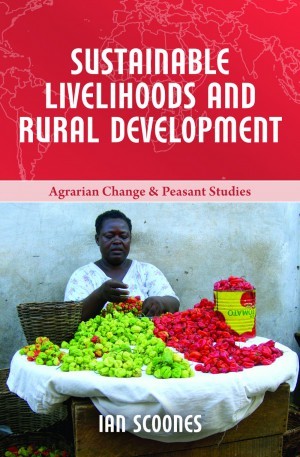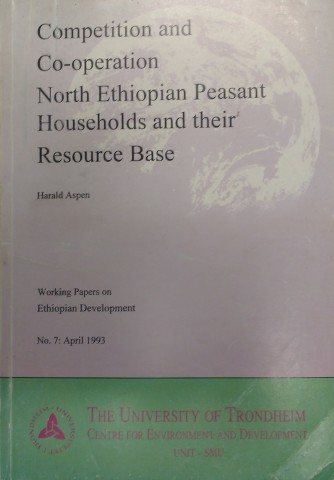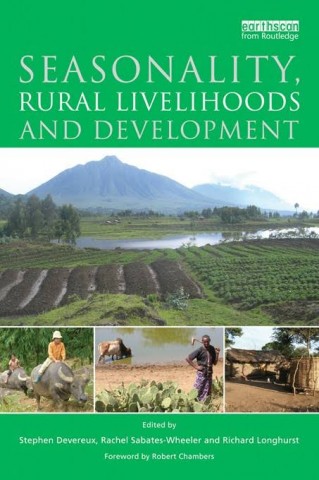If you are looking for an accessible introduction to research within thew broad umbrella of livelihoods that is well researched and provides a clear outline of what we have learned and what we need to know more about, this is it. Ian Scoones book "Sustainable Livelihoods and Rural Development" (2015) would do well for undergraduates or those from other disciplines seeking an overview. This is not a book for experts, but part of a series of short, informative books on selected topics related to Agrarian Change & Peasant Studies.
A previous post highlighted a publication from Ethiopia, which tend to be lesser known (and harder to find). This post highlights an old publication, similarly challenging to locate copies of, but may prove quite useful for those looking for historical data points for comparability: "Competition and Co-operation: North Ethiopian Peasant Households and their Resource Base" (1993) by Harald Aspen. The publication is more of a long manuscript than a book, and the author states that "by publishing the present work it is made available both to my colleagues in the PPDR programme, and to anyone else who may have some interest of the subjects treated here. Basically, this paper is a data report, but efforts have been made to comment and to suggest interpretations and means of analysis which can not necessarily always be directly read out of the empirical data presented" (p. 3).
Throughout, the book presents a variety of data sets on different aspects of smallholder lives and livelihoods. Since data is sparse for past periods, I found works such as these quite useful to explore what has changed, and also what has not. In this case, the data comes from the end of the Derg period. I highlight notes from Aspen's text, on marriage and debt:
"There are various means of getting a spouse, varying from contractual agreements involving a marriage feast and a written contract to elopement or (for males) abduction and 'raping' (t'alafa, probably most often with the consent of the prospective girl, i.e. a form of elopement). Between these extremes are cohabitation (sometimes as a preliminary to a formal marriage) as well as the occasional practice of 'hiring wives' for a limited period, where the 'wife' gets an annual amount of clothes and/or money from her 'husband' in return for sexual and domestic services. In the latter case the payment may be viewed as a compensation for the woman's renouncing of other assets belonging to the man in case of his death or if he decide to cancel the relationship. It is also not unusual for women not to remember much of their first encounter with a husband; several female informants have told that their first marriage was very short-lived: as young girls their parents had arranged their marriage and they took the first opportunity to escape from their husband, sometimes after a couple of probably unpleasant days" (p. 20)
"Key informants in Ganat reported that prior to the revolution, loans were accessible from professional moneylenders who usually charged an interest rate of 10% per month. After the revolution, credit in the form of cash has been less available, but whenever loans are given, they are interest free. The 1989 survey contained a small section on currently unsettled personal debt, and of the 210 household heads, only 29 (13.8%) reported to be indebted, of whom one was a woman. At the time of the survey, the tax obligations, when all 'special contributions' were included, were felt to be a heavy burden by most PA [Peasant Associations, now Kelebes] members in Ganat" (p. 81). Research in southern Ethiopia presented a much different picture on debt, as of 2015.
Robert Chambers states that "As a dimension of poverty, seasonality is as glaringly obvious as it is still grossly neglected. Attempts to embed its recognition in professional mindsets, policy and practices have still a long way to go" (Chambers, 2012: xv; in the Forward of Devereux, Sabates-Wheeler and Longhurst, 2012). This quote comes from an edited volume on seasonality, which brings together a range of interrelated topics revolving around the topic. The book itself draws upon works presented at a conference, and is a sort of follow-on to a similar conference (1978) and book (1981) – highlighting the research gap that has emerged since an interest in seasonality in the 1980s and early 1990s. Drawing upon the 2012 book, below are some of the key resources identified by the authors, as a means to further research on seasonality and support the identification of research taking seasonality as a focal point of study (in chronological order):
Chambers, R., Longhurst, R. and Pacey, A. 1981. Seasonal Dimensions to Rural Poverty. Frances Pinter: London.
Longhurst, R. (Ed) 1986. Seasonality and Poverty. IDS Bulletin 17(3).
Sahn, D. 1989. Seasonal Variability in Third World Agriculture: The Consequences for Food Security. Johns Hopkins University Press: London.
Chen, M. A. 1991. Coping with Seasonality and Drought. Sage: New Delhi.
Gill, G. 1991. Seasonality and Agriculture in the Developing World: A Problem of the Poor and Powerless. Cambridge University Press: Cambridge.
Ulijaszek, S. and Strickland, S. 1993. Seasonality and Human Ecology. Cambridge University Press: Cambridge.
Devereux, S. Vaitla, B. and Hauenstein-Swan, S. 2008. Seasons of Hunger. Pluto Press: London.
Devereux, S., Sabates-Wheeler, R. and Longhurst, R. 2012. Seasonality, Rural Livelihoods and Development. Earthscan: New York.
For those interested in more reading, I suggest the 2012 edited volume Seasonality, Rural Livelihoods and Development as a key resource from which many more references can be obtained.
Fish is a critical source of nutrition and livelihoods in low-income countries such as Bangladesh. WorldFish has played a key role in increasing the supply and availability of fish in low-income contexts through the Livestock & Fish CGIAR Research Program. This impact-oriented research will be the foundation for continuing innovation in fish breeding in the upcoming Fish Agri-foods CGIAR Research Program (FISH CRP). A major challenge for sustainable nutrition and livelihoods security is the development of robust strains of fish that meet the specific needs of poor women and men engaging in smallholder aquaculture. Currently, there are pressing gaps in knowledge regarding gendered preferences and outcomes. In particular, evidence is required as to whether, to what extent, and why the focus and results of fish genetic breeding programs have different outcomes for men and women. This includes the extent to which improved strains meet different needs that women and men may have, and in what way, such technologies may reinforce or shift gender roles, relations, and equity of outcomes. Addressing this gap is the primary focus of this Postdoctoral Fellow (PDF) position.
The PDF will tackle the overarching research question: How do the intended gender-equitable outcomes of the fish breeding program compare with the empirical gendered preferences and impacts, and what are the lessons for breeding program design, implementation and fish seed distribution? The PDF will do so through undertaking a systematic literature review and in depth, mixed methods empirical studies in Bangladesh in relation to the FISH CRP/WorldFish's tilapia and carp breeding program.
Additionally, the PDF will also play a key role in identifying, refining, and communicating to researchers across a range of FISH CRP countries insights into best practice and cutting-edge gender methods and strategies appropriate to different types and phases of aquaculture and fisheries research.
Latest peer reviewed articles, book chapters, reports, and working papers...
Read Logan's latest book reviews and research updates...


